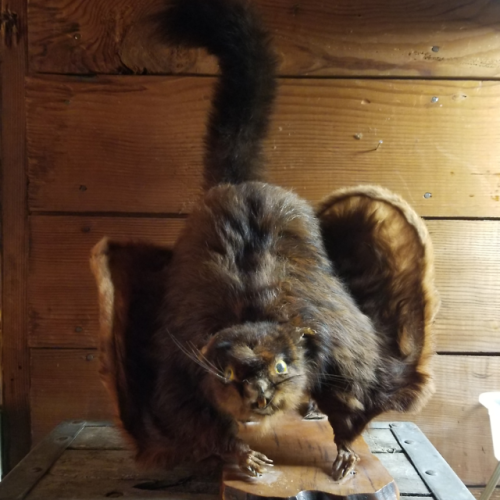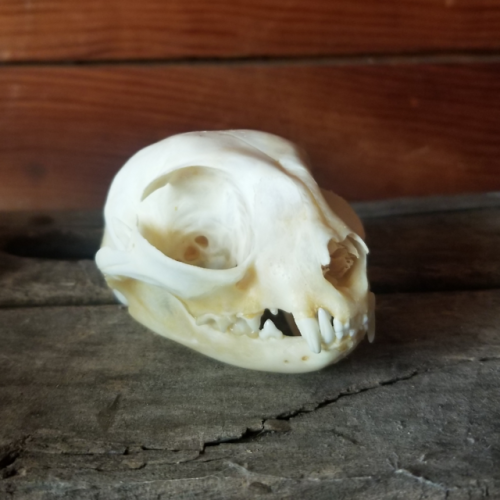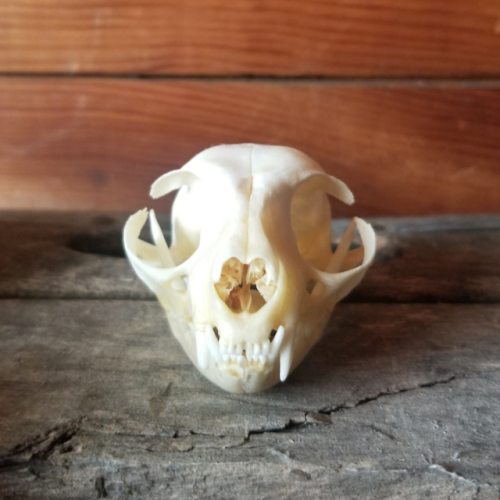#naturalhistory
Red giant flying squirrel!!!!! This piece is now available on our website! Hands down one of the most incredible and rare pieces. This one is guaranteed to put a smile on your face too.
http://www.thebelfryoddities.com/product/red-giant-flying-squirrel
Post link
This is such a cool and rare skull!!!! As you can see in the photos this cat had a pretty massive infection/cancer on its tooth that ate away at its teeth. This is a pretty rare abnormality to find and I’m excited to share it with you.
This would be a great addition to any collection!
FREE SHIPPING!!!. USA shipping only.
If you are in the Seattle area delivery or pickup is available
http://www.thebelfryoddities.com/product/abscess-cancer-cat-skull-pathological
Post link
Domestic cat skulls are now available on our website!!!!!! It’s been a long time but I’ve been able to track down some pretty impressive cat skulls for you all. This is hands down the most requested skull that I get. So don’t wait too long to order one! You know what to do.
www.thebelfryoddities.com
Post link





We had a great weekend teaching at the new Prey Taxidermy studio. It was our first Birds 101 class here— and it won’t be the last, don’t worry!
A big thank you to our fabulous students and to my team, @paloma.pajaro and @thehighandlow. Both Paloma & Lauren started out by taking this very class years ago!
In this class, students worked on the invasive but beautiful European Starling. They went from a frozen, dead bird to finished taxidermy in just two days. Bravo, you guys!
.

Just steaming this Peacock train and getting it to lay right.
Fun fact: the beautiful cascading feathers of a Peacock are not the tail; they’re actually specialized display feathers that sit on his back called the ‘train’. The tail is underneath and is a drab grey color.
You can see the tail easily when looking at a female, the Peahen. The species is collectively known as ‘Peafowl’.







Let’s talk about recreation taxidermy. All the photos here are of extinct animals, minus the humans who are very much thriving.
‘Recreation’ or ‘Reproduction’ taxidermy refers to utilizing specimens and/or taxidermy techniques to create an approximation of an extinct, rare or other species. These are usually for museums or educational purposes, but some taxidermists/artists just like the challenge.
This is a process involving both intense research and sculpture work. Many times the taxidermist / creator will consult or work directly with scientists to achieve the best guess at what these animals looked like.
Ken Walker, pictured here with his Irish Elk, actually used ancient cave paintings for some of his reference. He used several modern Elk hides pieced together for this Ice Age giant.
Next, you can see Carl Church’s wonderful Dodo. Though recently extinct, there are no Dodos left in modern collections; only bones and a charred head. Many descriptions and illustrations of Dodos were done by naturalists at the time, but there is much variation in them. Carl most likely had to review hundreds of sources as he decided on a plan.
Finally, this very recent Terror Bird recreation at Blue Rhino Studio for a museum diorama. You can see how the artist first sculpted a small maquette. I am sure several illustrations and versions were done - and perhaps weighed in on by collaborators. After all the aspects are refined here, it was then built to scale and actual feathers added. I adore this piece.
So, you can see that taxidermy is far from being a ‘dead art’. It’s truly breathing new life into species lost to time.

A bit about European Starlings: these feisty, metallic birds are the most numerous bird in North America despite being from, well, Europe.
Annoyingly, in 1890 a drug manufacturer named Eugene Schieffelin thought he knew better than Mother Nature and released around 60 of them in Central Park. He thought it was ‘a shame’ that America didn’t have the birds that Shakespeare wrote about.
Today, the ancestors of these birds decimate crops, resources and nests of native birds.
Every farmer or naturalist will tell you that the only good European Staring is a dead one - unless perhaps it resides in native Europe.
So, we’re putting some from pest control to good use in my classic Birds 101 class.



My account was hacked, sorry about all the sexual content.
::sigh:::
Let’s get back to our regularly scheduled programming: here is a Saw-Whet Owl piece I did a while back.
They’re one of the smallest owls in North America— and they’re gosh-darn cute.
One of my favorite facts about owls is that they cannot move their eyeballs; their eyeballs are actually bones except for the lens. This is why they have developed such a huge range of motion in their necks.
See? These kinds of hooters are more interesting.
EDIT: I saw some more posts from my hacking; they put photos in my queue. All gone now!

I’m having a giveaway from my adventures in Paris. Head on over to my Instagram to enter!










The Musée de la Chasse et de la Nature, or ’The Museum of the Hunt & Nature’, is a stunning collection of both classic and contemporary pieces. The museum itself is truly a piece of art that one wanders through. A celebration of man’s obsession with animals, hunting and conservation.
Artist Kohei Nawa’s gorgeous ‘PixCell Deer’ is currently on display along side classic stags and other fauna. From Japan, Nawa’s cultural belief in the sacred nature of deer cannot be more clearly defined here.
And, much to my delight, an entire room is focused on dogs. Louis XIV’s portraits of his hunting hounds and lap dogs are featured.
Modern works are sprinkled throughout this beautiful 1600s mansion. You might find modern sculptures decorating a vast antique gun collection or trophy room. I finally got to see one of Kate MccQwire’s stunning feather pieces. (I could not get a satisfactory photo sadly. Her work can be seen here: @kate_mccgwire)
Also in the collection is this expressively deceased bronze bear head by artist Nicolas Darrot. Shown simply here, it has a hidden bronze diorama within it’s neck.
Through its art, the collection also makes one look at the ways in which we utilize animals today. Pascal Bernier’s piece ‘Farm Set’ uses one taxidermy hen and a mirrored box to make a big statement about factory farming.
There’s no ‘bad taxidermy’ here and you can see the collections are truly alive. Wonderful to see such a vibrant institution supporting the past and the future of wildlife artistry and design.








Our replica reptiles class with Olivia Miseroy could not have gone better! 15 students learned posing, mold & casting, made their own resin snakes and painted their big rattlesnakes too. And, it was the first class at the new Prey studio!
A big thank you to Olivia for her expert instruction and dedication to her craft. We would love to do this class again and maybe do an advanced class too. You can follow Olivia at @terrafaunadesign
Thank you to my wonderful and talented students for coming. What a fantastic bunch! I can’t wait to see what you guys do next!
Oh, and we even enjoyed a lunch with our taxidermy-dad Tim Bovard, taxidermists at The Natural History Museum of Los Angeles.
Great weekend!










Just returned home from digging up Pleistocene fossils in rural Mexico with the La Brea Tar Pits crew and Western Arizona College Geology Lab.
The Pleistocene era is just 2.5 Million to 11,000 years ago roughly. Ice Age stuff, so no dinosaurs. A couple members of our crew found some very large pieces that even needed jacketing with plaster, which is very rare for this kind of fossil hunting.
My better finds were an antler (pic 1) and an ancient Camel metapodial bone (pic 5).
This is my 4th time volunteering to go on this trip and I loved learning from all the paleontologist there. Also, I managed to get some dog snuggles and a lot of hiking in. Bonus pic of a Scorpion under black light; they glow!








Here are some random process shots that one of my followers inspired me to post.
It’s nice to show finished pieces, but that’s not reality. The reality is, most everything is a work-in-progress; I’m constantly multitasking from piece to piece. It’s like how movies are shot out of order.
My specimens are pretty strange looking at first and I’m usually covered in foam or paint. All that matters is that the final presentation is accurate, tells a story and that you manage to scrub yourself clean.
The best way to make something is to first make a mess.

This is an adult American White Pelican I’ll be working on for the Maturango Museum. At 9 feet, this species has the second largest wingspan in North America (beat by the California Condor) and a horn on it’s beak during breeding season. Yeah. I’m pretty excited to be working on it.

Make sure to pick up the month’s National Geographic. My mentor and ‘taxidermy-dad’, Tim Bovard of NHMLA, is featured in the tool section.
This wonderful section showcases tools of different industries or sciences. This month they’re focusing on taxidermy!
I love how they laid out Tim’s classic tools— most of which Tim has had for many decades.
Wonderful to see our unique craft highlighted in this way. Congrats, Taxidermy Dad!
This ain’t Tiger King.
This clip is from the documentary about taxidermy called ‘Stuffed’. I was so honored to be a part of it and share my work on screen. If you have an interest in museums, taxidermy, animals or beautiful cinema, it’s out now streaming on Amazon Prime and on iTunes.
A big part of my work is spending time researching living animals; Watching them move, taking photos, studying behavior.
In this case, I was at Conservation Ambassadors. Basically the opposite of Tiger King. They do no breeding, no cub petting and are not open to the public. Instead, they take in animals from fires injuries, the illegal the pet trade and from Tiger King-type situations. These animals are cared for lifelong and the more social ones can be used for public education at schools.
One such soul is this Mountain Lion, Wyatt. He was 16 at the time and highly habituated to people due to his early life. You can see more about their work and donate to help them feed their animals at @conservation.ambassadors.zty
If you haven’t watched ‘Stuffed’ (and why haven’t you?!) you can get more info at @musicboxfilms and also check out our talented (and female ) director @historyboutique .
Flesh eating beetles?!
Yes! They exist and are known as Dermestid Beetles. Here they are cleaning a fox skull over 14 hours sped up.
These amazing creatures are commonly used by taxidermists, museum professionals, biologists, artists and other naturalists to clean bones.
One such artist is skeletal articulator, Gerard Geer of Australia. I was lucky to meet Gerard when we taught an articulation class at my studio a couple of years ago.
You can follow him at @articulated_imagination to see his creations if all kinds. He truly is an artist with a keen sense of anatomy and biology.

What’s in a tail? We see dogs wag them, cats flick them and Kangaroos jump with them. But what are they really?
If you look closely, you can see the tail is made up of vertebrae (caudal section), lots of tendons and even muscle tissue. The tail is an extension of the spine and has lots tight tendons; making it easy to be used as a type of rudder for the Fox. Tails have a lot of variation across species though and it’s truly fascinating to notes the differences.
Here you can see I’ve made an incision up the bottom of this Island Fox tail and have skinned it out. I’m then peeling it back for removal.
In the taxidermy mounting process, I will make a replica of the tail with wire and wrapped cotton.
I am aware that some taxidermists slide the tail out, aka ‘tubbing it’. For me, I cut it so I have full access for fleshing and tanning.

Mini fox! Meet the Island Fox. They’re basically the Corgis of the fox world because the have developed island-miniaturist aka insular dwarfism.
They are smaller with shorter limbs and even less vertebrae in their tail.
Why? Because they developed characteristics that benefited them for island living. Basically being small, low to the ground and a more veggie-heavy diet.
They descend from the mainland Grey Fox; their population floated or crossed an ice bridge to the Channel Islands of California around 10,000 to 20,000 years ago.
Over that time, they adapted into what we see today. There are six subspecies, each native and unique to their own island.
They also try to steal my marshmallows when I go camping on Catalina Island. But I don’t blame them because they’re cute. ***This is a protected and endangered species that I work on under special permits for a museum. ***

Another photo from my shoot fit The Washington Post @washingtonpostmag by @iancredible
I’m with a leusistic Raven I had been working on. Leucism is a genetic partial loss of most pigment, and does not result in the red eyes you see in albinism.
‘White Ravens’ such as this are extremely rare. I’ll share more about her once I get solo photos taken of her. In the meantime, please enjoy my ‘blue steel’ face.







